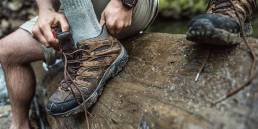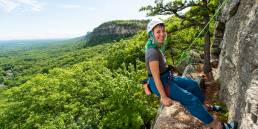Do you love to hit the trails but wonder, after decades of use and abuse, if your body is up to it? Are you a kid at heart but old by most hiking standards? As a seasoned peak bagger with more than six decades of experience everywhere from the Appalachian Trail to the Rockies who’s “aching” for more, trust me, you can hike well into your eighties. Over the years, I’ve had my ups and downs, thrills and spills, and starts and stops. Learn from my experiences and mistakes with these 10 tips for aging hikers to set yourself up for a successful hike.

10 Tips for Aging Hikers
1. Know “Why” Before Deciding When, Where, or with Whom
Understanding what attracts you to hiking can help you push through a hike when the going gets tough. Whether it’s camaraderie, escape, achievement, exercise, ticking an item off the bucket list, or redeeming a past failure, once you understand your motivation, put some goals on paper and start answering key questions like when, where, and with whom.
2. Give Yourself Time to Get in Hiking Shape
Training is key for older hikers. The more time you have to build up your leg strength and lung capacity, the better. Regularly hitting local trails, visiting the gym, and riding your bike are all good options. Remember, consistency is key—it’ll help build the base you need for a big peak.
On training hikes when you’re building up mileage, be sure to carry the pack you’re planning to take as well as the gear you’re planning to carry. As well, train in the footwear you’re planning to wear. This will help you shake out any potential problems—like hot spots if you have persnickety feet like mine. As I like to say, “Happy feet, happy hiker!”
3. Easy Does It
Many guidebooks rate hiking trails as easy, moderate, or difficult. When planning a hike, choose the trail that accommodates everybody in your party. That includes you.
Although I’ve bagged several 14ers in Colorado and hiked the Northeast’s highest peak (Mount Washington), these days the “difficult” hikes no longer call to me. Still, hiking is awesome and there are lots of great trails for every fitness level. There’s no shame in picking the trail that’s right for you.
4. Pace Yourself
Learning a few pacing tricks is key to maintaining a good time on the trails. The most obvious one is to take regular breaks to refuel. It’s preferable to stop for a bunch of short breaks, rather than a few long ones, which can cause aging muscles to tighten up.
While I’ve embraced drinking on the move with a hydration pack, there are still numerous reasons for occasionally pausing on the trail, such as to nibble some food, adjust your pack, tighten your shoes, and catch your breath—like I once found myself doing with increasing frequency on Mount Madison’s steep and unrelenting Osgood Trail.

5. Better Breathing
By this age, breathing seems pretty straightforward—but who says you can’t teach an old dog new tricks? Try synchronizing your breathing with the pace of your strides, inhaling as you step forward and exhaling with the next step of the same foot. As you settle into the hike take fewer, deeper breaths coordinated with more strides to fall into a natural rhythm.
6. Don’t Overpack
Hiking is challenging enough—there’s no need to increase the difficulty by carrying more weight than you need to. Thinking critically about the items you put in your pack, embracing ultralight gear, and strategically thinking about food and water can help you cover more ground and save wear and tear on your body.
If hiking in the White Mountains, another option is to consider incorporating one of the AMC huts into your trip, which can eliminate the need to carry a tent, cookware, and meals.
7. Account for Your Age
Bodies break down, so humble yourself. You might not be as fast as you used to be and you might even get passed by a four-year-old and her Goldendoodle—take inspiration from faster parties and encouragement from older hikers moving at your pace.
8. Go With Friends
I’m a big believer in buddying up and believe there’s wisdom in the old adage that “two is better than one.” Hiking with a partner(s) provides an abundance of benefits. For example, it’s more sociable, supportive, and fun. It also builds in an extra level of safety. If something goes wrong—whether it’s feeling fatigued, running short on food, spraining an ankle, or suffering a medical emergency—there’s an extra set of hands to help.

9. Use Hiking Poles
There are a bunch of good reasons to use trekking poles. This is especially true for older hikers. Hiking poles help you maintain your balance, provide stability on uneven terrain, and lessen the impact the trail has on your lower body—all of which add up to make them a must-have for older hikers.
10. Use Your Experience
While older hikers might not have the same fitness they possessed in their youth, they typically have years of experience on trail. Listen to your body, respect the mountains, and remember the lessons you’ve learned along the way. If your body says stop, the weather feels off, or the plan seems overly ambitious, call it a day. The mountains will be there tomorrow.
Dietrich Gruen
Dietrich Gruen is a freelance writer, editor, and minister-at-large, from Madison, Wisconsin.
Related Posts
April 24, 2024
What to Bring When Road Tripping with Your Dog
Prepare for the ultimate road trip with…




